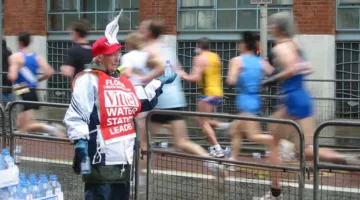
With so many winter and early spring marathons these days, it’s a perfect way for the off-season triathlete to build and maintain aerobic endurance for the next season.
Even for those who haven’t ventured beyond the sprint or Olympic distance triathlon, training for and completing a marathon this winter or spring will pay great dividends in your long-term conditioning. Marathon training will establish a solid running base, which is necessary anyway in the typical year-round triathlon training plan.
Completing a marathon (as well as biking a century) is especially helpful for triathletes aspiring to complete in an Ironman triathlon. These long-distance running and cycling events help familiarize you with the demands of the Ironman distances. If you can’t run a marathon or bike a century, how do you expect to do both of them together after a long swim?
So, let’s start first with completing in a marathon. How can a triathlete best train for a marathon?
I’m making the assumption that as a triathlete, you have a fairly high level of overall fitness.
What follows is a 16-week marathon training plan that includes: total weekly run mileage; your weekly long run, and weeks where swim and bike sessions are included.
Weekly Training Sessions For A Marathon
| Week | Total Mileage | Long Run | Swim/ Bike |
|---|---|---|---|
| 1: | 30 | 8 | swim/bike |
| 2: | 40 | 13 | swim/bike |
| 3: | 50 | 16 | swim/bike |
| 4: | 60 | 20 | off |
| 5: | 65 | 18 | swim |
| 6: | 60 | 16 | swim/bike |
| 7: | 55 | 21 | off |
| 8: | 50 | 13 | swim/bike |
| 9: | 50 | 20 | off |
| 10: | 45 | 18 | swim |
| 11: | 45 | 14 | swim/bike |
| 12: | 45 | 18 | swim |
| 13: | 40 | 14 | swim/bike |
| 14: | 40 | 17 | swim/bike |
| 15: | 35 | 16 | off |
| 16: | 35 | 14 | swim/bike |

In following the above program, the triathlete does one run each week equaling the mileage listed in the column for long run and then divides the remainder of the total running mileage among the 3-5 other days of the week.
The last column indicates what weeks to include swim and bike sessions, swim only sessions, or an “off” week where no swim or bike sessions are added.
Here are a few examples of how you might break down a specific training week into daily training sessions:
Daily Training Session For A Marathon
| Week 3: 50 miles | Activity 1 | Activity 2 |
|---|---|---|
| Monday | 8 mile run | 30 min. swim |
| Tuesday | 60 min. bike or spin | 6 mile run |
| Wednesday | off | |
| Thursday | 10 mile run | |
| Friday | 6 mile run | 30 min. swim |
| Saturday | 16 mile run | |
| Sunday | 4 mile run |
| Week 10: 45 miles | Activity 1 | Activity 2 |
|---|---|---|
| Monday | 10 mile run | |
| Tuesday | 7 mile run | 30 min. swim |
| Wednesday | off | |
| Thursday | 10 mile run | |
| Friday | 30 min. swim | |
| Saturday | 18 mile run | |
| Sunday | 30 min. swim |
| Week 14: 40 miles | Activity 1 | Activity 2 |
|---|---|---|
| Monday | 30 min. swim | 90 min. bike or spin |
| Tuesday | 8 mile run | |
| Wednesday | 10 mile run | |
| Thursday | 5 mile run | 30 min. swim |
| Friday | 90 min. bike or spin | |
| Saturday | 17 mile run | |
| Sunday | off |
| Week 16: 35 miles | Activity 1 | Activity 2 |
|---|---|---|
| Monday | 30 min. swim | 90 min. bike or spin |
| Tuesday | 10 mile run | |
| Wednesday | 60 min. swim | |
| Thursday | 8 mile run | |
| Friday | 3 mile run | 90 min. bike or spin |
| Saturday | 14 mile run | |
| Sunday | off |
The above plan obviously focuses on running mileage but incorporates some swimming and biking sessions. These sessions should be considered recovery-level workouts with a focus on technique. On days where you run, and add a swim or bike session; it’s your choice on whether you combine them into one training block or split them up into a 2-session training day. If you are combining them as one training block, doing the swim after a run will aid in recovery from the run.
Critical Marathon Training Principles:
- Have the proper marathon gear.
- Employ marathon tapering.
- Plan a race day strategy
- Follow a marathon recovery plan
Downsides To Doing Off-Season Marathons
Some feel there is a downside for a triathlete doing an off-season marathon. This would especially apply if running is your weak sport.
There is the view that training for a marathon will not necessarily make a weak runner better, and that it would be more beneficial in the off-season to work on running technique with running drills.
Perhaps this could be augmented with a half marathon instead of a full marathon, which is often a very difficult event for inexperienced r
unners. In some cases, it can take up to a month to fully recover from a marathon, and the concern is that the experience will drain your energy needed for the triathlon racing season.
Different Types Of Marathons

There are also those who feel that the comparison between a marathon race and the marathon-distance run in an Ironman triathlon are very different. For most triathletes, an Ironman is an exercise in energy management. The great majority of Ironman triathletes walk during portions of the marathon to insure fluid and food intake. The Ironman marathon is more like a training run.
A solo marathon event, on the other hand, is more an exercise in pain management: the pace is high, and runners barely break stride to get that half-cup of water. Most runners do not walk — unless they hit the wall. It is a very different event.
Running a marathon in the winter only proves that you can run a marathon and you can handle a 3- to 5-hour effort. Top performers in marathons are not necessarily the best triathletes or Ironman competitors. Performance at one does not translate to the other.
An alternative plan, if your main desire is to build a strong Ironman running base, is scheduling a few long training runs of 20+ miles during training. This should mentally prepare a triathlete that has any doubts of their capability to complete a marathon.
In Sum…
To be realistic, triathletes are goal-oriented people driven by endurance competitions. Which means, most triathletes have a desire to try their hand at all kinds of endurance events other than triathlons — such as a marathon.
Many people who become triathletes are runners and have already achieved the goal of completing a marathon. Hypocritically, most of the triathletes who say don’t do it have themselves run one or more marathons.
So, if you are a triathlete and want to complete a marathon, I say, go for it! It might be helpful to remember that you don’t have to achieve all your triathlon and endurance sport goals in one year. If you train for and complete a marathon this winter and spring, perhaps schedule your triathlon events for late summer and early fall, and stick to the Olympic-distance triathlon.
You could also schedule your 70.3 triathlon or Ironman triathlon for next season. In other words, you might think of goal-setting in 3-year blocks:
- Perhaps your year 1 big goal is to complete a 70.3 triathlon.
- Year 2 is completing a marathon or cross-country bike event.
- Year 3 is the full Ironman.



